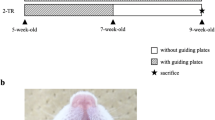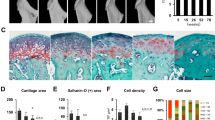Abstract
Mandibular hypoplasia is a common jaw deformity that affects breathing, occlusal function and facial aesthetics. Stimulating mandibular condylar growing with functional appliances is an ordinary but controversial treatment method in orthodontics. Therefore, it is vital to clarify how functional appliances affect condylar growing. Raf-1 kinase inhibitor protein (RKIP), as an endogenous inhibitory molecule of the ERK signaling, is postulated to involve in stress-induced response to articular cartilage. This study was to reveal the role of RKIP in regulating cartilage matrix synthesis with functional appliance treatment. Here, position rat mandibular forward simulating functional appliance effect to examine the stress-induced modification of mandibular condylar in vivo, meanwhile rat mandibular condylar chondrocytes (Mccs) were subjected to cyclic tensile stress (CTS, 16%, 1 HZ). The results showed that mandibular forward therapy enhanced condylar cartilage growth. The thicknesses of all layers of condylar cartilage were increased significantly. RKIP expression was also increased in the mature cartilage layer. In addition, CTS could enhance extracellular matrix formation and cartilage marker expression (aggrecan and collagen II), which shared a similar expression pattern with RKIP in Mccs. However, CTS induced up-regulation of collagen II and aggrecan was blocked by RKIP knockdown. Nuclear p-ERK, targeting downstream of RKIP, showed a decrease after CTS,which was disappeared in RKIP-knockdown Mccs. Taken together, physiological mechanical stimulation promotes cartilage growth modification by up-regulating RKIP through inhibiting ERK signaling pathway.





Similar content being viewed by others
References
Bishara SE (2006) Class II malocclusions: diagnostic and clinical considerations with and without treatment. Semin Orthod 12:11–24
Bleuel J, Zaucke F, Bruggemann GP, Niehoff A (2015) Effects of cyclic tensile strain on chondrocyte metabolism: a systematic review. PLoS ONE 10:e0119816
Chen Z, Yue SX, Zhou G, Greenfield EM, Murakami S (2015) ERK1 and ERK2 regulate chondrocyte terminal differentiation during endochondral bone formation. J Bone Miner Res 30:765–774
Chu FT, Tang GH, Hu Z, Qian YF, Shen G (2008) Mandibular functional positioning only in vertical dimension contributes to condylar adaptation evidenced by concomitant expressions of L-Sox5 and type II collagen. Arch Oral Biol 53:567–574
Cui J, Li J, Wang W, Han X, Du J, Sun J, Feng W, Liu B, Liu H, Amizuka N, Li M (2016) The effect of calcitriol on high mobility group box 1 expression in periodontal ligament cells during orthodontic tooth movement in rats. J Mol Histol 47(2):221–228
Embree MC, Kilts TM, Ono M, Inkson CA, Syed-Picard F et al (2010) Biglycan and fibromodulin have essential roles in regulating chondrogenesis and extracellular matrix turnover in temporomandibular joint osteoarthritis. Am J Pathol 176:812–826
Fu HD, Wang BK, Wan ZQ, Lin H, Chang ML, Han GL. (2016) Wnt5a mediated canonical Wnt signaling pathway activation in orthodontic tooth movement: possible role in the tension force-induced bone formation. J Mol Histol. 47(5):455–466
Hagan S, Garcia R, Dhillon A, Kolch W (2006) Raf kinase inhibitor protein regulation of raf and MAPK signaling. Methods Enzymol 407:248–259
Li H, Yang HS, Wu TJ, Zhang XY, Jiang WH et al (2010) Proteomic analysis of early-response to mechanical stress in neonatal rat mandibular condylar chondrocytes. J Cell Physiol 223:610–622
Ma B, Leijten JC, Wu L, Kip M, van Blitterswijk CA et al (2013) Gene expression profiling of dedifferentiated human articular chondrocytes in monolayer culture. Osteoarthritis Cartilage 21:599–603
Matsushita T, Chan YY, Kawanami A, Balmes G, Landreth GE et al (2009) Extracellular signal-regulated kinase 1 (ERK1) and ERK2 play essential roles in osteoblast differentiation and in supporting osteoclastogenesis. Mol Cell Biol 29:5843–5857
Murakami S, Balmes G, McKinney S, Zhang Z, Givol D et al (2004) Constitutive activation of MEK1 in chondrocytes causes Stat1-independent achondroplasia-like dwarfism and rescues the Fgfr3-deficient mouse phenotype. Genes Dev 18:290–305
Prasadam I, Mao X, Wang Y, Shi W, Crawford R et al (2012) Inhibition of p38 pathway leads to OA-like changes in a rat animal model. Rheumatology 51:813–823
Rabie AB, She TT, Hagg U (2003a) Functional appliance therapy accelerates and enhances condylar growth. Am J Orthod Dentofacial Orthop 123:40–48
Rabie AB, Wong L, Tsai M (2003b) Replicating mesenchymal cells in the condyle and the glenoid fossa during mandibular forward positioning. Am J Orthod Dentofacial Orthop 123:49–57
Ruf S, Pancherz H (1999) Temporomandibular joint remodeling in adolescents and young adults during Herbst treatment: A prospective longitudinal magnetic resonance imaging and cephalometric radiographic investigation. Am J Orthod Dentofacial Orthop 115:607–618
Shen G, Hagg U, Rabie AB, Kaluarachchi K (2005) Identification of temporal pattern of mandibular condylar growth: a molecular and biochemical experiment. Orthod Craniofac Res 8:114–122
Shibata S, Suzuki S, Tengan T, Ishii M, Kuroda T (1996) A histological study of the developing condylar cartilage of the fetal mouse mandible using coronal sections. Arch Oral Biol 41:47–54
Silbermann M, Frommer J (1972) The nature of endochondral ossification in the mandibular condyle of the mouse. Anat Rec 172:659–667
Singh M, Detamore MS (2008) Tensile properties of the mandibular condylar cartilage. J Biomech Eng 130:011009
Singh M, Detamore MS (2009) Biomechanical properties of the mandibular condylar cartilage and their relevance to the TMJ disc. J Biomech 42:405–417
Sobue T, Yeh WC, Chhibber A, Utreja A, Diaz-Doran V et al (2011) Murine TMJ loading causes increased proliferation and chondrocyte maturation. J Dent Res 90:512–516
Takahashi I, Onodera K, Bae JW, Mitani H, Sasano Y et al (2005) Age-related changes in the expression of gelatinase and tissue inhibitor of metalloproteinase genes in mandibular condylar, growth plate, and articular cartilage in rats. J Mol Histol 36:355–366
Trakul N, Rosner MR (2005) Modulation of the MAP kinase signaling cascade by Raf kinase inhibitory protein. Cell Res 15:19–23
Tulloch JF, Proffit WR, Phillips C (2004) Outcomes in a 2-phase randomized clinical trial of early class II treatment. Am J Orthod Dentofacial Orthop 125:657–667
Utreja A, Dyment NA, Yadav S, Villa MM, Li Y et al (2016) Cell and matrix response of temporomandibular cartilage to mechanical loading. Osteoarthritis Cartilage 24:335–344
Wang C, Gu W, Sun B, Zhang Y, Ji Y, Xu X, Wen Y (2017) CTHRC1 promotes osteogenic differentiation of periodontal ligament stem cells by regulating TAZ. J Mol Histol 48(4):311–319
Watt FM (1988) Effect of seeding density on stability of the differentiated phenotype of pig articular chondrocytes in culture. J Cell Sci 89(Pt 3):373–378
Xu L, Peng H, Glasson S, Lee PL, Hu K et al (2007) Increased expression of the collagen receptor discoidin domain receptor 2 in articular cartilage as a key event in the pathogenesis of osteoarthritis. Arthritis Rheum 56:2663–2673
Yang H, Luo S, Wang Y (1999) The behaviour of rat mandibular condylar cartilage in cell culture. Hua Xi Yi Ke Da Xue Xue Bao 30:23–25
Yip-Schneider MT, Miao W, Lin A, Barnard DS, Tzivion G et al (2000) Regulation of the Raf-1 kinase domain by phosphorylation and 14-3-3 association. Biochem J 351:151–159
Zhou T, Guo S, Zhang Y, Weng Y, Wang L, Ma J (2017) GATA4 regulates osteoblastic differentiation and bone remodeling via p38-mediated signaling. J Mol Hist 48:187–197
Acknowledgements
This research is supported by the National Key Clinical Specialist Construction Programs of China,Natural Science Foundation of Jiangsu Province, China (BK20150999), and Natural science fund for colleges and universities in Jiangsu Province, China (15KJB320004). We thank the Jiangsu Key Laboratory of Oral Diseases from the Stomatology Collage of Nanjing Medical University for providing experimental equipment.
Author information
Authors and Affiliations
Contributions
Conceived and designed the experiments: LW, WBZ. Performed the experiments: LS, JZ. Analyzed the data: HW. Contributed reagents/materials/analysis tools: YP. Wrote the paper: LS.
Corresponding authors
Ethics declarations
Conflict of interest
Lian Sun and Jing Zhao contributed equally to this work. All authors declare that there are not any financial and personal relationships with other people or organizations that could potentially and inappropriately influence (bias) their work and conclusions.
Additional information
Lian Sun and Jing Zhao have contributed equally to this work.
Electronic supplementary material
Below is the link to the electronic supplementary material.
10735_2017_9741_MOESM1_ESM.eps
Supplement 1 Forward mandibular positioning rat model. Mental tube with a 135 degree angle leaned to labial side was bonded to lower incisors to simulate functional appliance effect (S1 a). X-ray was used to exam sagittal and vertical opening lengths of mandibular(S1 b). (EPS 16641 KB)
10735_2017_9741_MOESM2_ESM.eps
Supplement 2 Identification of mandibular condylar chondrocytes (Mccs). The morphology of the P2 chondrocytes was observed under a microscope (S2 a). The alcian blue staining was positive in the chondrocytes (S2 b). The immunofluorescence staining for type II collagen was positive in the chondrocytes (S2 c). (EPS 21450 KB)
Rights and permissions
About this article
Cite this article
Sun, L., Zhao, J., Wang, H. et al. Mechanical stress promotes matrix synthesis of mandibular condylar cartilage via the RKIP-ERK pathway. J Mol Hist 48, 437–446 (2017). https://doi.org/10.1007/s10735-017-9741-4
Received:
Accepted:
Published:
Issue Date:
DOI: https://doi.org/10.1007/s10735-017-9741-4




